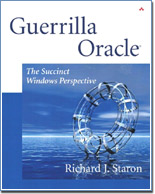Guerrilla Oracle: The Succinct Windows Perspective
 Author: Richard Staron
Author: Richard Staron
Pages: 496
Publisher: Addison-Wesley
ISBN: 0201750775
Introduction
Are you frustrated by your attempts to learn Oracle or improve your Oracle skills because of the sheer amount of technical documentation you have to wade through? This tutorial walks you step-by step through the process, showing you exactly what you need to know to install, create, and support a successful Oracle8i or 9i environment with Web capabilities.
About the author
Richard J. Staron is manager of IS applications at Eastern Connecticut State University. He has more than twenty years of experience in the data processing field, including hierarchical and relational database design. Richard has extensive experience managing Oracle database installations, supervising Oracle programmers, and teaching Oracle programming.
Inside the book
Are you an Oracle newbie? If your answer is yes, read on. You want to learn Oracle, right? After all, it’s not that hard, if you have a good guide. Here comes Guerrilla Oracle. The book consists of 15 chapters. After the introduction, chapter 2 offers a concise overview of the most significant dates and events in the history of databases.
Chapter 3 starts with a discussion on the key concepts behind the relational databases (tables, relationships and data integrity enforcement with constraints). The discussion of the key concepts is extended from theoretical aspects at the beginning of the chapter to more “practical” aspects. Here the author describes the Oracle Server environment, what SQL is, what the basic SQL commands are and what PL/SQL is. In addition, an overview of SQL*Plus, Oracle Forms and Reports builder, and some of the other development tools is also given.
Chapter 4 and chapter 5 are organized as Oracle schema design case study. A set of database objects (tables, etc.) are designed from the ground up.
Chapter 6 covers some of the most important components of an Oracle server. Here you will find what is an Oracle instance, database physical layout and tablespaces and what is a user schema. This knowledge is essential to understand and successfully accomplish the process of installing an Oracle server, as described in chapter 7. How to configure a fresh installed Oracle server, mostly from a security standpoint is discussed in chapter 8. Topics such as system security, data security, user security, password management policy, auditing, creating users, roles, granting privileges and finding all the relevant information from the data dictionary are described here.
In chapter 9 we could find how to create a table space, and how to populate a user schema with objects (database tables, etc.) designed from the ground up in chapters 4 and 5. When the user account is populated with objects, the Oracle data dictionary is the right place to find and access all the relevant information about database objects. Oracle provides views and tables of the database, all its users, and its various structures. Here you’ll find how the dictionary works, what the data dictionary views are, and how to usFor those who would like to know how to publish forms on the web the requirements list i.e. the available information.
In chapter 11 the process of installing an Oracle client is described. This is a very important step for connecting from client machines to an Oracle instance on the server machine.
Chapter 12 aimed to teach the users how to perform some of the common and very important tasks usually performed by a real DBA (database administrator). Tasks such as how to upgrade a system, Oracle licensing policy, how to startup and shutdown an Oracle server, how to perform logical and physical backups and how to tune the Oracle instance are described here.
The rest of the book is focused on the most used development tools in Oracle projects today. In chapter 13, firstable, you’ll learn how to install the Forms6i builder. Then, the author guides through the various components of an Oracle form, and finally how to build a real GUI form. When building a form, there is a need to display the data loaded in the database. Chapter 14 explains how to do simple reporting, perform calculations, how to ask the database (build queries), etc.
Steps on how to move forms from a client/server based model to the Web and HTTP access is described in the rest of the chapter 15. How to acquire a very basic understanding of Oracle9i Application Server, what is a three-tier system, what is iSQL*Plus and how to install Oracle9i Application Server is described here.
What I think of it
As already stated, this book is organized as a concise step by step tutorial. It is certainly not meant to be a definitive guide to the Oracle technology world as only the official Oracle products documentation has more than 40,000 pages. For an absolute beginner, this book offers deeper understanding of the Oracle RDBMS, and will certainly help to learn concrete skills, strategies and techniques you need to make your first steps in the Oracle world and begin exploring more complex technical topics.

